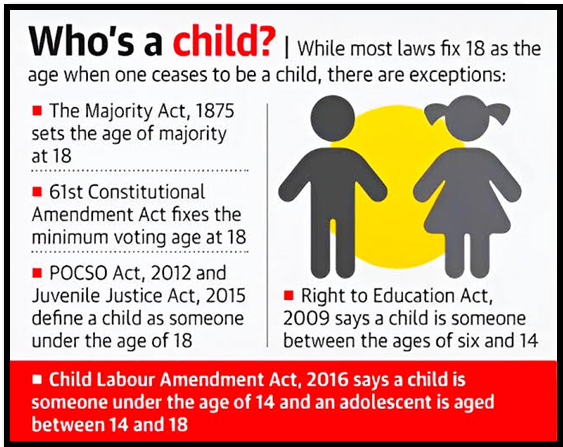Supreme court tightens laws on child pornography
Syllabus:
GS-2:
Issues Related to Children ,Government Policies & Interventions
Focus:
The Supreme Court expanded the definition of child pornography possession, introducing stricter penalties for viewing, sharing, or failing to report such material under the POCSO Act.
Supreme Court Ruling Overview:
- The Supreme Court of India has significantly expanded the definition of “possession” under child pornography laws.
- The new ruling now includes viewing or displaying child pornography as possession.
- This change enhances the scope of the Protection of Children from Sexual Offences (POCSO) Act, specifically addressing Sections 15(1), (2), and (3), which stipulate punishments based on the degree of offence.
About the Protection of Children from Sexual Offences (POCSO) Act 2012:
- Purpose: Enacted to address sexual exploitation and abuse of children after India ratified the UN Convention on the Rights of the Child in 1992.
- Definition of a Child: Any person below 18 years.
- Punishments: Vary based on the severity of the offence; amended in 2019 to include stringent penalties, including the death penalty for severe crimes against children.
- POCSO Rules, 2020: Introduced to implement the Act effectively.
Key Features
- Gender-Neutral: Recognizes that both boys and girls can be victims, ensuring equal protection under the law.
- Ease of Reporting: Non-reporting of child sexual exploitation is a specific offence, promoting awareness and accountability.
- Explicit Definitions: Clearly defines offenses like child pornography and sexual assault, distinguishing them from vague terms in existing laws.
- Immediate Relief: CWC can recommend immediate financial aid for children’s essential needs, mandated within a week of the recommendation.
Legislations Regulating Child Pornography
- Section 67B of IT Act, 2000:
- Covers various aspects, including publishing child pornography and facilitating online abuse.
- Section 14 of POCSO Act, 2012:
- Imprisonment of at least five years for using children for pornographic purposes, increasing to seven years for repeat offenders.
Initiatives to Curb Child Abuse:
- Child Abuse Prevention and Investigation Unit: Specialized units established to prevent and investigate child abuse cases effectively.
- Beti Bachao Beti Padhao: Government campaign aimed at addressing gender discrimination and ensuring the survival, protection, and education of the girl child.
- Juvenile Justice (Care and Protection of Children) Act, 2015: Provides a legal framework for the care, protection, and rehabilitation of children in need.
- Child Marriage Prohibition Act (2006): Prohibits child marriages, aiming to protect children from early and forced marriages.
- Child Labour Prohibition and Regulation Act, 2016: Bans the employment of children in hazardous industries and regulates conditions of work for children.
- Fast Track Special Courts (FTSCs): Established to expedite trials of sexual offences against children, ensuring timely justice.
Key Highlights of the Ruling:
- Viewing as Possession: The court clarified that simply viewing or displaying child pornography constitutes possession, which can lead to criminal charges, even if no downloading or storage occurs.
- Punishment for Intent: If an individual views child pornography with the intent to share or distribute it, they can be prosecuted under Section 15, regardless of whether they actually share the content.
- Failure to Act: The court ruled that failing to delete or report such material also falls under the definition of possession, indicating a broader interpretation of responsibility regarding child pornography.
Legal Precedents and Changes
- This ruling follows a case where a Madras High Court decision previously quashed criminal proceedings related to child pornography charges.
- The Supreme Court’s recent verdict counters this by affirming that charges can be made if an individual possesses or displays child pornography, even if they don’t actively distribute it.
- The court emphasised the need to tighten the law around child pornography, responding to a pressing social issue with stringent measures.
Implications for Law Enforcement
- Increased Responsibility: The ruling places a greater responsibility on law enforcement to act against individuals who merely view or fail to report child pornography.
- Guidelines for Authorities: Police and judicial authorities are urged to broaden their investigations and not limit inquiries to mere possession but to include acts of viewing and failing to delete or report such content.
- Prosecution Guidelines: The Supreme Court provided guidelines indicating that intent to share, even without physical distribution, can lead to prosecution.
Detailed Analysis of the Law
- Legal Definition of Possession: The court elaborated that possession is not solely about physical storage; it encompasses any form of control over the material, including viewing it on a device.
- Criminal Charges: The ruling stipulates that any act related to child pornography—whether downloading, viewing, or even failing to delete—can be subject to criminal charges under the POCSO Act.
- Possession in Different Contexts: The court highlighted that the circumstances surrounding the viewing of child pornography will be considered to determine whether a person has committed an offence.
Case Studies and Examples
- The court provided illustrations to clarify its ruling:
- If an individual watches child pornography on a mobile device and deletes it immediately, they could still be charged if it is proven they had knowledge of the material.
- If someone views child pornography with the intention to distribute it, this intent could lead to charges, even if the material is not shared.
Challenges in Combating Child Pornography:
- Limited Awareness: Many people, including law enforcement, lack awareness of child pornography laws and how to report incidents effectively.
- Inadequate Reporting Mechanisms: Current systems for reporting child pornography are often complex and unwelcoming, discouraging victims and witnesses from coming forward.
- Technological Obstacles: Rapid advancements in technology complicate the detection and tracking of child pornography, making it easier for offenders to exploit loopholes.
- Underreporting of Cases: Cultural stigmas surrounding child abuse lead to significant underreporting, leaving many cases unaddressed.
- Judicial Delays: Slow judicial processes hinder timely justice for victims, allowing offenders to evade punishment.
- Resource Constraints: Limited financial and human resources within law enforcement agencies impede their ability to effectively investigate and prosecute cases.
- Cross-border Jurisdiction Issues: Child pornography often involves cross-border elements, complicating enforcement due to differing laws and cooperation challenges.
Way Forward:
- Public Awareness Campaigns: Launch nationwide campaigns to educate citizens about child pornography laws and reporting mechanisms.
- Streamlined Reporting Systems: Develop user-friendly online platforms for reporting incidents of child pornography.
- Enhanced Training: Provide specialised training for law enforcement on identifying and addressing child pornography effectively.
- Invest in Technology: Invest in advanced technologies for monitoring and tracking online child exploitation.
- Judicial Reforms: Expedite judicial processes related to child pornography cases to ensure timely justice.
- Allocate Resources: Increase funding and resources for child protection agencies and law enforcement.
- International Cooperation: Foster international collaboration to address cross-border child pornography issues and standardise laws.
Conclusion:
Combatting child pornography requires a multi-faceted approach that includes enhancing awareness, streamlining reporting mechanisms, leveraging technology, and fostering international cooperation. By addressing the challenges and implementing effective strategies, society can protect vulnerable children, ensure justice for victims, and hold perpetrators accountable, thus promoting a safer environment for all.
Source: The Indian Express
Mains Practice Question:
Discuss the challenges faced in combating child pornography in India and suggest measures to overcome them.Evaluate the effectiveness of current laws, such as the POCSO Act, in addressing child pornography and propose improvements to enhance their impact.
Associated Article:
https://universalinstitutions.com/pocso-cases-cannot-be-quashed-on-settlement-grounds/





